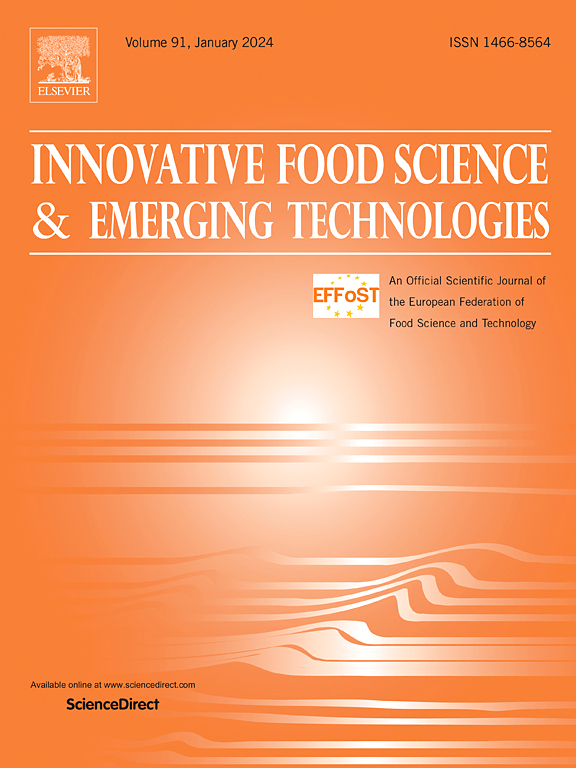Ultrafast osmotic distillation for cranberry juice concentration with hydrophilic ionic liquid as receiving phase
IF 6.3
1区 农林科学
Q1 FOOD SCIENCE & TECHNOLOGY
Innovative Food Science & Emerging Technologies
Pub Date : 2025-04-19
DOI:10.1016/j.ifset.2025.104026
引用次数: 0
Abstract
This study presents an innovative application of the hydrophilic ionic liquid (IL) 1-methyl-3-octylimidazolium chloride as a novel receiving phase in the osmotic distillation (OD) process for cranberry juice concentration. A hydrophobic hollow fiber membrane module was employed, operating at a 10:1 juice-to-IL volumetric ratio and 30 °C, achieving a maximum transmembrane flux of 2.5 kg m−2 h−1.
The findings demonstrate the potential of ILs to enhance process efficiency while preserving key quality attributes like total soluble solids, phenolic compounds, and aroma which are critical for consumer acceptance. A resistance-in-series mathematical model accurately predicted mass and heat transfer behavior, identifying the membrane pores as the dominant resistance to mass transfer, approximately 400 times greater than other transport steps.
Compared to conventional OD using saturated CaCl₂ brine and flash drying techniques, IL-based OD showed superior performance in retaining sensory and nutritional quality, while also reducing energy consumption. This study contributes to the development of scalable and resource-efficient food processing technologies by demonstrating the feasibility of ILs as emerging alternatives for gentle concentration processes. The results offer meaningful implications for sustainable food production, aligning with current industry demands for mild, innovative processing strategies that preserve high-value product integrity and extend shelf life.
以亲水离子液体为接收相的超快渗透蒸馏浓缩蔓越莓汁
本研究提出了亲水离子液体(IL) - 1-甲基-3-辛基咪唑氯作为新型接收相在渗透蒸馏(OD)工艺中浓缩蔓越莓汁的创新应用。采用疏水中空纤维膜模块,在30°C和10:1的液液体积比下工作,最大跨膜通量为2.5 kg m−2 h−1。研究结果表明,ILs在提高工艺效率的同时,保留了关键的质量属性,如总可溶性固体、酚类化合物和香气,这些都是消费者接受度的关键。串联阻力数学模型准确预测了质量和传热行为,确定膜孔是主要的传质阻力,大约是其他传递步骤的400倍。与使用饱和氯化钙卤水和闪蒸干燥技术的传统外包装相比,基于il的外包装在保持感官和营养品质方面表现出更好的性能,同时还降低了能耗。本研究通过证明il作为温和浓缩过程的新兴替代方案的可行性,有助于开发可扩展和资源高效的食品加工技术。研究结果为可持续食品生产提供了有意义的启示,与当前行业对温和、创新的加工策略的需求保持一致,这些策略可以保持高价值产品的完整性并延长保质期。
本文章由计算机程序翻译,如有差异,请以英文原文为准。
求助全文
约1分钟内获得全文
求助全文
来源期刊
CiteScore
12.00
自引率
6.10%
发文量
259
审稿时长
25 days
期刊介绍:
Innovative Food Science and Emerging Technologies (IFSET) aims to provide the highest quality original contributions and few, mainly upon invitation, reviews on and highly innovative developments in food science and emerging food process technologies. The significance of the results either for the science community or for industrial R&D groups must be specified. Papers submitted must be of highest scientific quality and only those advancing current scientific knowledge and understanding or with technical relevance will be considered.

 求助内容:
求助内容: 应助结果提醒方式:
应助结果提醒方式:


